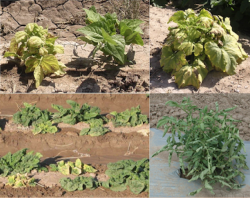February 24, 2018
Curly Top Virus: Hints for Healthy Tomatoes
Question:
Last season all three of my tomatoes got curly top. Are there varieties that are more resistant?
- Brittany E., Albuquerque, NM
Answer:
The short answer is no, but there are some interesting ways to increase your chances of tomato glory. Let’s start with general info about curly top virus. Dr. Stephanie Walker, our NMSU Extension Vegetable Specialist, talked me through the problem and the solutions.

It is spread by one insect pest, the beet leafhopper (Circulifer tenellus; Fig. 1), which is known to maintain or increase populations while living on winter weeds like London rocket (Sisymbrium irio) and redstem filaree (Erodium cicutarium), among others. Timing is everything. When the winter weed hosts start dying at the end of their peak season, guess who has been recently planted and is ready to be the new habitat for the hungry beet leafhoppers and the viral disease they bring with them? Our precious tomato starts, that’s who (Fig. 2).

Beet curly top virus (the formal common name) is by far the biggest problem for both commercial and residential tomato growers across the state. In fact, this disease is a major problem in many arid regions, partly due to its wide host range of over 300 species in 44 plant families, including sugar beets, green chile (gasp!), and tomatoes. However, different symptoms may appear based on host species or maturity level of the host. NMSU Extension Guide H-106: Curly Top Virus,” by Dr. Natalie Goldberg.
… when young plants are infected they will often die shortly after infection. When plants are infected after the seedling stage, the plants survive but are yellow and stunted. Infected leaves of some hosts, particularly tomatoes and peppers, become thickened and crisp or stiff, and roll upward as the petioles curve downward. The leaves turn yellow with purplish veins. Leaves of other hosts such as beets become very twisted and curly [Fig. 3]. In most cases, yield is reduced, and the fruit that is produced ripens prematurely. The immature, dull and wrinkled fruit is a good diagnostic symptom for tomatoes infected with [curly top virus]. If plants are infected after they have begun to set fruit, it is not uncommon to see infected and healthy fruit on the same stem…

Back to our tomato woes. Unfortunately, no tomato varieties are completely resistant to beet curly top virus. That being said, plum and other small tomato varieties, such as ‘Sweet 100’, ‘Yellow pear’, and ‘Tiny Tim’, tend to hold up better to curly top as well as other diseases and disorders. They may be more tolerant of the virus, but they are still not bulletproof. In years with high populations of beet leafhopper, even smaller varieties go down if they are bitten by virus-carrying beet leafhoppers.
There are no known chemicals for controlling the virus, and it only takes one minute for a beet leafhopper to transmit the virus while feeding on a leaf. Therefore, it all comes down to preventing beet leafhoppers from reaching your tomato plants. Here are four tricks:
-
Cage the tomatoes with insect netting material as soon as transplants go in the ground and keep the netting on all season. Use row covers with holes small enough that the approximately 3 mm-long insects are not able to hop right through. Keep tomato leaves from rubbing up against the netting sides where leafhoppers might be able to sneak a bite. Inside the insect netting, tomato flowers will still easily set fruit because the flowers are self-fertile.
-
Remove and discard diseased plants promptly. If you need help identifying either the insect or viral pest, contact your NMSU County Extension Agent or the NMSU Plant Diagnostic Clinic or both.
-
Unlike the rest of us, the beet leafhopper does not like shade. There is evidence that shading your tomato plants (30–50% recommended shade rating) will increase the chances of a good tomato crop. Tomatoes and other vegetable crops may perform better in the shade anyway, and need less water to boot.
-
Beet leafhopper populations are higher in years that have high volumes of winter weeds. And it’s not just the winter weeds that beet leafhoppers rely on for food and shelter. Other weeds, like kochia (Kochia scoparia) and Russian thistle (Salsola tragus), also bolster beet leafhopper populations and serve as a reservoir for curly top virus. Weed ’em and reap.
Marisa Y. Thompson, PhD, is the Extension Horticulture Specialist, in the Department of Extension Plant Sciences at the New Mexico State University Los Lunas Agricultural Science Center, email: desertblooms@nmsu.edu, office: 505-865-7340, ext. 113.
Links:
For more gardening information, visit the NMSU Extension Horticulture page at Desert Blooms and the NMSU Horticulture Publications page.
Send gardening questions to Southwest Yard and Garden - Attn: Dr. Marisa Thompson at desertblooms@nmsu.edu, or at the Desert Blooms Facebook page.
Please copy your County Extension Agent and indicate your county of residence when you submit your question!